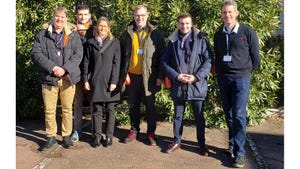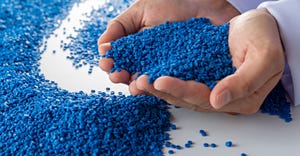IMM's Plant Tour: Home-grown automation
September 8, 1998
Not many custom molders knowingly turn down business in order to improve services for key customers. Ten years ago, Thermotech, a division of Menasha Corp. that specializes in precision molding, handled business from over 1100 customers. Today, that number stands at 285. When IMM conducted a recent tour of the Hopkins, MN facility (division headquarters), we asked Don Griwac, regional sales manager, the obvious question.
His reply? "We realized our major customers' requirements were increasing, especially in the areas of design support, production, and secondary operations." Design support, for instance, now includes early involvement to assist in design for moldability and effective tooling design. "At first, it was our automotive customers who began asking for more involvement," Griwac says. "But today, all the markets we serve require a greater degree of responsibility, such as having Thermotech sales and technical people onsite daily. We also hold technical seminars for customers to increase their knowledge of mold capabilities.
"To serve those needs effectively, we had to dedicate more resources to fewer accounts. As a result, we pared down the customer list to include higher volume, key customers that were the focal point of our business."
This rather straightforward attitude pervades most of the functions at the Hopkins plant. Management doesn't hesitate to make investments in leading-edge technology and equipment when the need arises. By the same token, there seems to be no need for bells and whistles that don't add value to the customer-focused, precision molding operation's goals.
Supporting the Process
Molding floors at Thermotech are, of course, where the plastic meets the mold. But to make the process truly efficient, the company has carefully structured its support functions as a system of checks and balances for upfront troubleshooting.
For example, the plant contains an extensive materials analysis laboratory run by manager Lynn Braunworth. The lab primarily performs incoming resin inspection and post-molding material degradation checks for all three Thermotech plants. "Although we don't perform physical testing here, incoming resin shipments are checked for contamination, molecular weight, correct chemistry, and identity of fillers and reinforcements," she says. Techniques include gel permeation chromatography, thermal analysis, infrared spectroscopy, rheology, and microstructural analysis.
Information gained from materials testing helps optimize the molding cycle, according to Braunworth. "We can set tool temperatures to produce a part in which all the required characteristics are fully developed within a stable cycle." By the way, as with Dickten & Masch, profiled recently, the lab operates as a profit center, offering its services to competitors as well as resin suppliers.
A complete computer training facility is available onsite. Employees take courses at their own pace on subjects ranging from computer functions and press setups to more advanced processing training. Much of the coursework is provided by A. Routsis Assoc.
An in-house automation department designs and builds all the automated and semi-automated manufacturing cells. It's a large area staffed with mechanical and electrical engineers who take requirements for insert molding, bobbins, and other projects and translate them into machinery that can automate the molding process.
For example, engineers build universal wire insertion tooling assembled in a modular design for easy maintenance. The machine allows them to insert several different sizes of square wire for different jobs. Built into each piece of computer-controlled equipment are fixture stops that allow the machine to be reas-sembled after maintenance with no guesswork. Alarms within the computer control alert technicians to nonfunctioning areas.
Thermotech's manufacturing engineering department provides support for automation and workcell ergonomics when a job goes to production. The production planning department supports customer service and helps to schedule various jobs on the molding floor.
In the inspection room, Thermotech uses its Zeiss C700 coordinate measuring machine for reverse engineering and to help determine what kind of 'windage' needs to be put into a mold. Griwac explains: "Round holes in plastic parts may require that the mold pin making the hole be slightly out-of-round. We determine to what dimensions the mold pin must be made to produce a perfectly round feature on the part."
A class 100,000 cleanroom with 16 machines ranging from 80 to 250 tons, several of them electric, began operating nine years ago. A wide variety of parts for major medical OEM customers are molded according to GMP and are FDA-compliant.
Toward Zero Defects
Doing upfront design and analysis work goes a long way toward building quality into a part. Thermotech also believes investing in computer technology is another key to achieving zero defects.
To ensure part quality at the press, the shop employs closed loop controls on all its machines, as well as mold temperature controllers, desiccant dryers, and moisture analyzers. In addition, a Mattec plant floor monitoring system controls dump-chute diverters at each machine. When the process exceeds engineering control limits, the system activates the diverter, and the parts are separated.
Within its design group, Thermotech maintains several seats of EDS Unigraphics CAD/CAM as well as PC-based Cadkey. Moldfilling analyses are conducted via Moldflow Dynamic Series. In most cases, designers get involved early in a project so they can perform moldfilling and design for moldability studies.
In one case, however, the molder inherited a part not designed for moldability. Griwac tells us, "It was molded from PEI, but contained thick and thin wall sections that couldn't be changed. Our lab worked with the material supplier to define what was happening during molding."
The part had to withstand 100 lb of pressure. At first, it began cracking at anywhere from 10 to 385 lb--too broad a range. "Once the lab got involved, we were able to refine the process. We've been doing destructive testing now and, in three years, have found only one bad part."
On an enterprise-wide basis, Thermotech has invested in an extensive computer software system called SAP (System Application Products). Parent company Menasha has already implemented SAP in two other divisions. The software, produced in Germany, is used by many Fortune 500 companies to handle business information, such as accounting, as well as planning and resource management. Some functions are centralized where necessary, but the package allows for operational tailoring for each division with a seamless interface between both types of information. That means the Hopkins plant can track orders, add data from its plant monitoring system, and log machinery maintenance on the same system that provides access to corporate information.
In the Customer's Shoes
Many molding businesses claim to be customer focused, but Griwac recounts a recent experience that puts some weight behind the words at Thermotech: "An automotive OEM called in three top molders to evaluate a proposed project, involving a throttle-body housing that was spec'd to be molded in PPS. The parts would be used on the European version of this automaker's vehicles.
"We all met together, which was unusual, and the customer said one of us would walk away with the job. Each molder presented a proposal for tool design, gating, and molding cycle. In the end, Thermotech's approach got the green light.
"At first, the meeting resembled a feeding frenzy with all of us wanting to modify the OEM's design." All the molders wanted to increase the tolerances, which were quite stringent. But after more consideration, Griwac realized his organization had already proved they could achieve the tolerances requested. That was the first breakthrough.
For the finale, "We had a slightly different approach to gating the cylindrical throttle-body housing," he recalls. "We knew a traditional gate design would cause flashing that could potentially damage the throttle within.
"We gated from the outside using one of our proprietary bobbin tools. The project actually came in ahead of schedule, and our customer avoided problems in the long run."
Thermotech's team put themselves in the customer's shoes, and, ultimately, that was what won them the job and the customer's approval. It is a lesson Thermotech continues to employ in its daily operations.
The changing business of molding
After six months of strategic planning, Thermotech has a clear direction for the future. The plan, called Focused Innovation, involves maintaining a leading-edge position in certain types of processing technologies. "This is where we've carved our niche over the past few decades," says general manager John Bonham, "and we want to ensure that we continue to lead in high-tech, precision molding."
Customers are changing, too, he adds, driving more design responsibility to the molder level. "The real question is how do we as a business derive value out of that?" Bonham asks. "Comparing piece-part prices is no longer valid, when the value we deliver includes the millions of dollars we can save customers through innovative design engineering upfront to help direct programs initially so they can be more successful. At times, no matter what is done upfront, custom molders are still judged on the piece-part price by purchasing functions that are often decoupled from manufacturing and production. That is the challenge facing us today."
Supplier consolidation at the OEM level also presents a change in the way molders conduct business today. Many OEMs want to choose a molder to handle all their business, but, says Bonham, that's not necessarily efficient. "We don't want to be all things to all people; we want to stay where we deliver the most value, which is in challenging, precision molding. So we must define how we fit with a customer's operation before getting involved."
You May Also Like


